Nobel Peace Prize facts for kids
Quick facts for kids Nobel Peace Prize |
||||
|---|---|---|---|---|
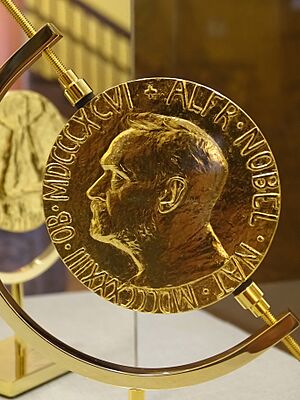
Jimmy Carter's 2002 Nobel Peace Prize
|
||||
| Presented by | Norwegian Nobel Committee on behalf of the estate of Alfred Nobel | |||
| Location | Oslo, Norway | |||
| Reward | 11 million SEK (2023) 10 million SEK (2022) |
|||
| First awarded | 10 December 1901 | |||
| Currently held by | María Corina Machado (2025) | |||
|
||||
The Nobel Peace Prize is one of the five important Nobel Prizes. These prizes were created by the last wishes of Alfred Nobel, a Swedish inventor and businessman. The other Nobel Prizes are for Chemistry, Physics, Medicine, and Literature.
Since 1901, the Peace Prize has been given almost every year. It honors people who have "done the most or the best work for friendship between nations." It also recognizes efforts to reduce armies and promote peace congresses (meetings for peace). Many people consider it the most respected award in the world.
The Norwegian Nobel Committee chooses the winner. This committee has five members chosen by the Parliament of Norway. The award ceremony takes place in Oslo, Norway.
The 2025 prize was awarded to María Corina Machado. She received it for her hard work in promoting democratic rights in Venezuela. She also worked to help her country move from a dictatorship to a peaceful democracy.
Contents
What is the Nobel Peace Prize?
The Nobel Peace Prize is a special award given to individuals or groups. It celebrates their efforts to make the world a more peaceful place. This can include working for friendship between countries. It also includes trying to reduce the number of armies. Supporting meetings that promote peace is also a key factor.
Who was Alfred Nobel?
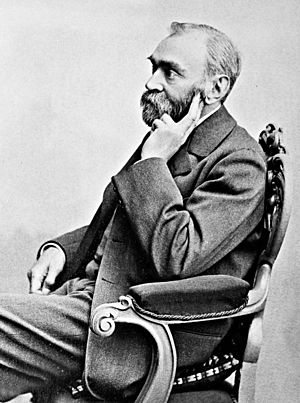
Alfred Nobel was a Swedish inventor. He was born in 1833 and died in 1896. He invented dynamite and other explosives. These inventions made him very wealthy. However, they were also used in wars and conflicts.
Nobel wanted to leave a better legacy after his death. He decided to use his fortune to create prizes. These prizes would honor people who made great contributions to humanity.
Why a Peace Prize?
It is not fully clear why Nobel chose to include a peace prize. He was a chemical engineer, so prizes for chemistry and physics made sense. Some believe his friendship with Bertha von Suttner influenced him. She was a peace activist and later won the prize herself.
Other experts think Nobel wanted to make up for his inventions. Dynamite and other explosives he created were used in violent ways. He also helped turn a company called Bofors into a weapons manufacturer.
There is a famous story, which might not be entirely true. In 1888, a newspaper mistakenly published Nobel's obituary (death notice). It called him "the merchant of death." It said he got rich by finding ways to kill more people faster. This story suggests that Nobel wanted to change how people remembered him. He wanted to be known for promoting peace.
Nobel also chose Norway to administer the Peace Prize. At the time, Norway was part of Sweden. The Nobel Committee believes Norway was a good choice. Norway did not have the same strong military history as Sweden. Also, the Norwegian parliament was active in solving conflicts peacefully.
How are Winners Chosen?
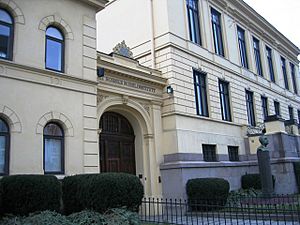
The Norwegian Parliament chooses the Norwegian Nobel Committee. This committee is responsible for selecting the Nobel Peace Prize winner.
Who Can Nominate?
Each year, the Norwegian Nobel Committee invites certain people to suggest names. These people are allowed to nominate candidates for the prize. They include:
- Members of national parliaments and governments.
- Members of important international courts.
- University professors in subjects like history, social sciences, and law.
- Leaders of universities and peace research centers.
- Past winners of the Nobel Peace Prize.
- Current and former members of the Norwegian Nobel Committee.
Nominations must usually be sent by early February each year. The committee keeps all nomination information secret for at least 50 years. This means we don't know who was nominated until many years later. Sometimes, people are called "Nobel Peace Prize Nominees." This just means someone suggested their name. For example, in 1939, Adolf Hitler received a joke nomination from a Swedish politician. This shows that not all nominations are serious.
The Selection Process
The Nobel Committee reviews all the nominations. They create a shortlist of top candidates. Experts at the Nobel Institute then study these candidates. They write reports about their work.
The committee uses these reports to make its final decision. They try to agree on one winner. The decision is usually made in mid-September. The official announcement happens in early October.
Receiving the Award
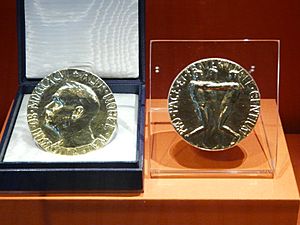
The Nobel Peace Prize ceremony happens every year on December 10. This date is the anniversary of Alfred Nobel's death. The Chairman of the Norwegian Nobel Committee presents the prize. The King of Norway and the Norwegian royal family are usually present.
The Peace Prize is the only Nobel Prize not given out in Stockholm, Sweden. The winner receives a special diploma, a gold medal, and money. The amount of money changes each year. It depends on how well Nobel's investments have done. In recent years, it has been about 10 million Swedish Krona. This is roughly 1 million US dollars.
Since 1990, the ceremony has taken place at Oslo City Hall. Before that, it was held in other locations in Oslo.
The Nobel Peace Prize Medal
The medal for the Peace Prize was designed by a Norwegian sculptor named Gustav Vigeland. He created it in 1901. The medal shows a picture of Alfred Nobel.
The back of the medal shows three men in a "bond of brotherhood." It has a Latin inscription that says, "Pro pace et fraternitate gentium." This means "For the peace and brotherhood of men." The edge of the medal also has the year it was awarded and the winner's name.
Past Winners of the Peace Prize
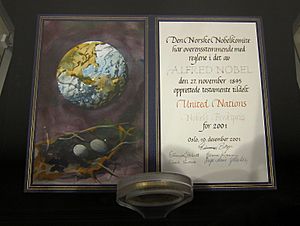
As of October 2023, the Peace Prize has been given to 111 individuals and 27 organizations. Nineteen women have won this prize, which is more than any other Nobel Prize.
Some winners have received the prize multiple times. The International Committee of the Red Cross has won three times (in 1917, 1944, and 1963). The United Nations High Commissioner for Refugees has won twice (in 1954 and 1981). Only one person, Lê Đức Thọ, has ever refused to accept the prize.
Images for kids
-
The 14th Dalai Lama and Archbishop Desmond Tutu, both Nobel Peace Prize winners.
-
Yasser Arafat, Shimon Peres, and Yitzhak Rabin with their 1994 Nobel Peace Prize.
See also
 In Spanish: Premio Nobel de la Paz para niños
In Spanish: Premio Nobel de la Paz para niños
- Gandhi Peace Prize
- Sakharov Prize
- Mosaddegh Prize



